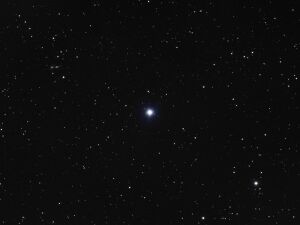Astronomy:2 Lyncis
| Observation data Equinox J2000.0]] (ICRS) | |
|---|---|
| Constellation | Lynx |
| Right ascension | 06h 19m 37.38458s[1] |
| Declination | +59° 00′ 39.4683″[1] |
| Apparent magnitude (V) | 4.44[2] |
| Characteristics | |
| Spectral type | A2 Vs[3] |
| B−V color index | 0.032±0.004[2] |
| Variable type | Eclipsing binary[4] |
| Astrometry | |
| Radial velocity (Rv) | −2.0±0.1[5] km/s |
| Proper motion (μ) | RA: −5.35[1] mas/yr Dec.: +23.86[1] mas/yr |
| Parallax (π) | 20.83 ± 0.40[1] mas |
| Distance | 157 ± 3 ly (48.0 ± 0.9 pc) |
| Absolute magnitude (MV) | 1.03[2] |
| Orbit[6] | |
| Period (P) | 1306.82±0.96 d |
| Eccentricity (e) | 0.497±0.010 |
| Periastron epoch (T) | 2450962.0±2.0 |
| Argument of periastron (ω) (secondary) | 186.30±0.79° |
| Semi-amplitude (K1) (primary) | 3.281±0.044 km/s |
| Details[6] | |
| 2 Lyn A | |
| Mass | 2.32±0.02[3] M☉ |
| Radius | 2.2 R☉ |
| Luminosity | 39.5+1.8 −1.7[3] L☉ |
| Surface gravity (log g) | 4.1±0.1 cgs |
| Temperature | 9,310±100 K |
| Rotation | 1.56 d |
| Rotational velocity (v sin i) | 44 km/s |
| 2 Lyn B | |
| Mass | 0.46 M☉ |
| Other designations | |
| Database references | |
| SIMBAD | data |
2 Lyncis is a binary star system in the northern constellation Lynx. It is visible to the naked eye, having an apparent visual magnitude of 4.44.[2] The distance to this system, judging by an annual parallax shift of 20.83±0.40 mas,[1] is around 157 light years. It is moving closer to the Sun with a heliocentric radial velocity of −2 km/s.[5]
This is a spectroscopic binary star system with an orbital period of around 3.6 years and an eccentricity of 0.5. It is classified as a probable (91% chance) eclipsing binary with the variable star designation UZ Lyn, showing a net magnitude decrease of 0.3 during an occultation.[4]
The primary component is an A-type main-sequence star[6] with a stellar classification of A2 Vs,[3] where the 's' indicates narrow (sharp) absorption lines. The orbiting companion may be the source of the X-ray emission from this system, as stars similar to the primary component do not generally produce detectable levels of X-rays.[8]
References
- ↑ 1.0 1.1 1.2 1.3 1.4 1.5 van Leeuwen, F. (2007), "Validation of the new Hipparcos reduction", Astronomy and Astrophysics 474 (2): 653–664, doi:10.1051/0004-6361:20078357, Bibcode: 2007A&A...474..653V.
- ↑ 2.0 2.1 2.2 2.3 Anderson, E.; Francis, Ch. (2012), "XHIP: An extended hipparcos compilation", Astronomy Letters 38 (5): 331, doi:10.1134/S1063773712050015, Bibcode: 2012AstL...38..331A.
- ↑ 3.0 3.1 3.2 3.3 Zorec, J.; Royer, F. (2012), "Rotational velocities of A-type stars. IV. Evolution of rotational velocities", Astronomy & Astrophysics 537: A120, doi:10.1051/0004-6361/201117691, Bibcode: 2012A&A...537A.120Z.
- ↑ 4.0 4.1 Avvakumova, E. A. et al. (October 2013), "Eclipsing variables: Catalogue and classification", Astronomische Nachrichten 334 (8): 860, doi:10.1002/asna.201311942, Bibcode: 2013AN....334..860A, http://elar.urfu.ru/bitstream/10995/27061/1/scopus-2013-0239.pdf
- ↑ 5.0 5.1 de Bruijne, J. H. J.; Eilers, A.-C. (October 2012), "Radial velocities for the HIPPARCOS-Gaia Hundred-Thousand-Proper-Motion project", Astronomy & Astrophysics 546: 14, doi:10.1051/0004-6361/201219219, A61, Bibcode: 2012A&A...546A..61D.
- ↑ 6.0 6.1 6.2 Lehmann, H. et al. (April 2003), "Binary nature and elemental abundances of 2 Lyn and HD 169981", Astronomy and Astrophysics 402: 229–235, doi:10.1051/0004-6361:20030253, Bibcode: 2003A&A...402..229L.
- ↑ "2 Lyn". SIMBAD. Centre de données astronomiques de Strasbourg. http://simbad.u-strasbg.fr/simbad/sim-basic?Ident=2+Lyn.
- ↑ De Rosa, R. J. et al. (July 2011), "The Volume-limited A-Star (VAST) survey - I. Companions and the unexpected X-ray detection of B6-A7 stars", Monthly Notices of the Royal Astronomical Society 415 (1): 854–866, doi:10.1111/j.1365-2966.2011.18765.x, Bibcode: 2011MNRAS.415..854D.
 |


